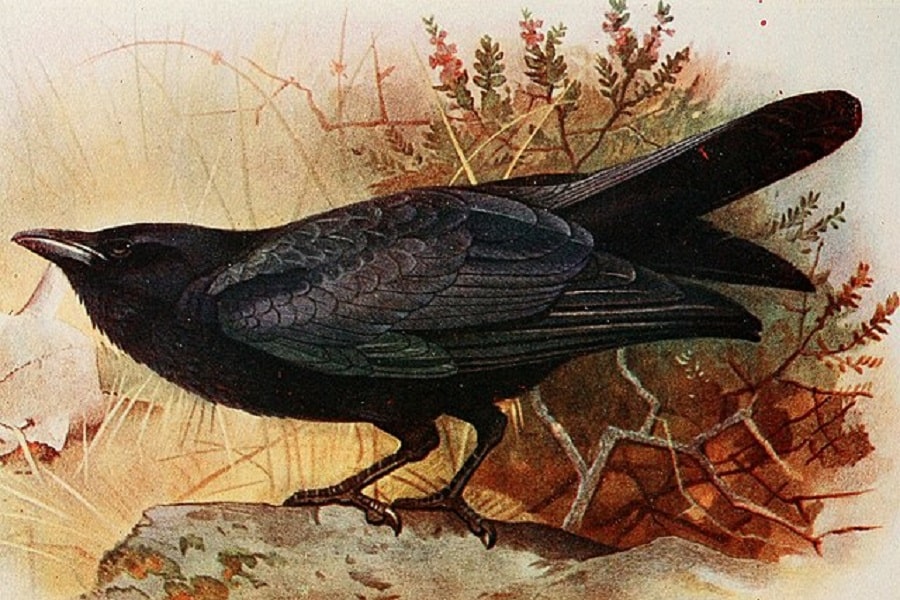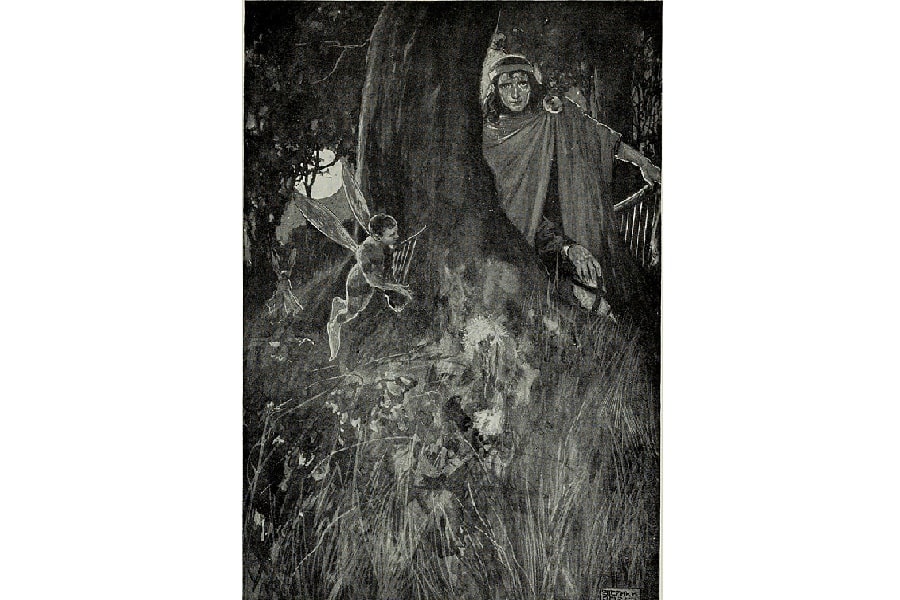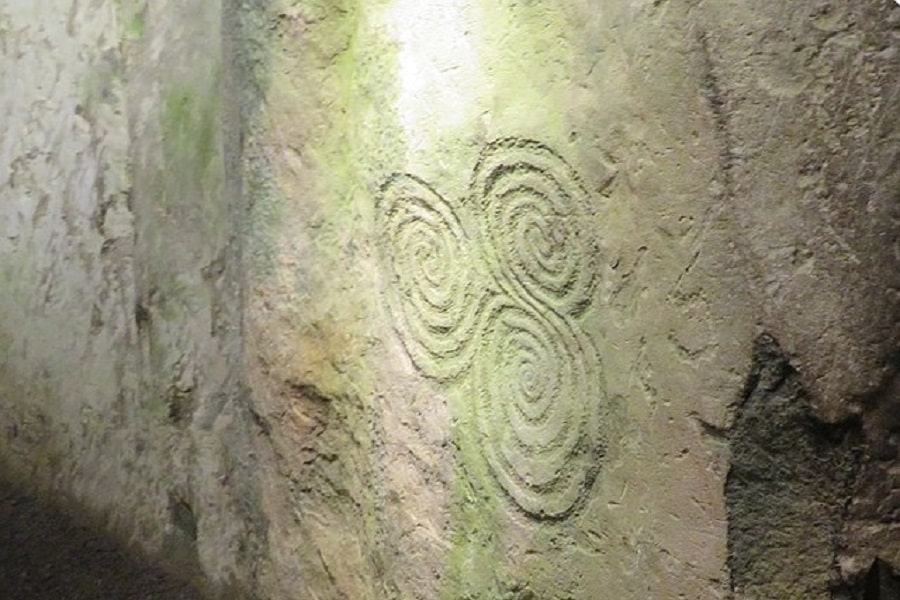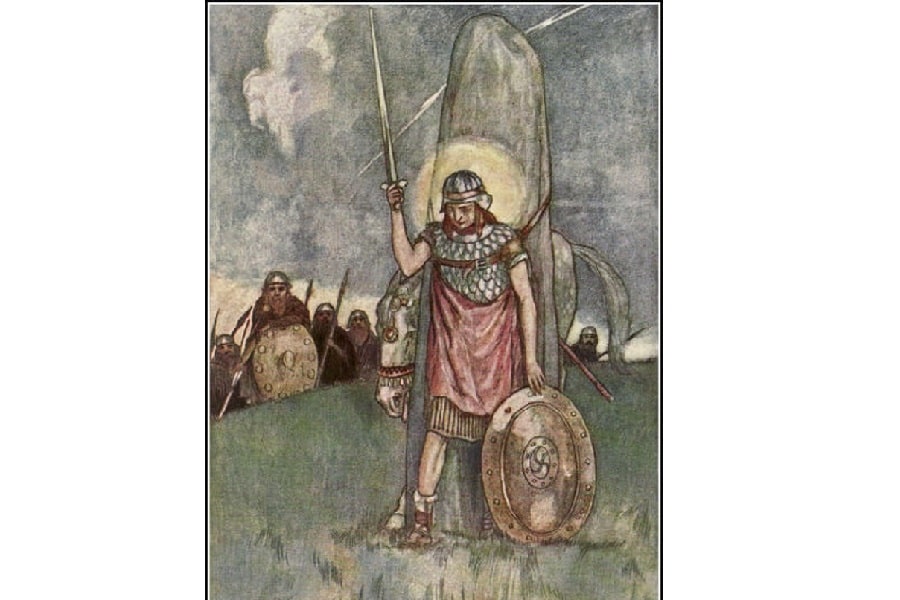The Morrigan is a complex and enigmatic goddess from Celtic mythology associated with various aspects, including war, fate, sovereignty, and prophecy.
The Morrigan is often depicted as a fierce and battle-ready figure, sometimes appearing as a crow or raven on the battlefield, inspiring warriors or predicting the outcome of conflicts. She is known to have the ability to shape-shift, assuming the form of different animals or a human woman, which she uses to interact with mortals and other deities.
Table of Contents
What Was the Morrigan the Goddess Of?

The Morrigan (also sometimes called Morrigua) was an ancient Irish goddess with the heat of war and often the scales of fate. Due to her multifaceted roles, she was viewed as a triple goddess manifesting herself in animal forms and foretelling the doom of those who dared strike against her forces.
Of course, her badass significance can’t be overlooked.
To really understand the impact of the Morrigan, you can compare her to other pagan goddesses and mythological beings. These might include the Valkyries from Norse mythology, the Furies, and even Kali, the deity of destruction and transformation in Hindu mythology.
Basically, the Morrigan is the absolute manifestation of raw carnage and total war.
In the Name: Why is She Called the Morrigan?
The origins of the Morrigan’s name have seen much dispute across scholarly literature.
But don’t worry; this is super normal as the etymological roots of such ancient figures are generally lost to time, especially when Celtic myths were passed down only through oral retelling.
When breaking the name down, one might see traces of Indo-European, Old English, and Scandinavian origins. But almost all traces have one thing in common: they are all equally morbid.
Words such as “terror,” “death,” and “nightmare” have all seen footing inside her name. In fact, the syllable of the Morrigan, which is “Mor,” sounds eerily similar to “Mors,” Latin for “Death .” Safe to say, all of this solidifies the Morrigan’s status of being associated with doom, terror, and battle.
One other popular interpretation of her name is “phantom queen”, or the “great queen.” Given how her ghostly and nimble aura pairs beautifully with the chaos of a furious battle, it is only fair she is interpreted as such.
The Role of Morrigan in Celtic Society
Being a fury and war goddess, the Morrigan might’ve been tethered to the very cycle of life.
As she is often mentioned alongside another god in his prime, the Dagda (the Good God), she might’ve represented the polar yet protagonistic opposite of tranquility. As with any other mythology, the need for a deity ruling over the notions of destruction and death is always significant.
After all, human civilization has been through quite a lot of it.
To the ancient Irish, the Morrigan might have been a goddess (or goddesses) invoked during a battle; all so her grace could lead them to victory. To her enemies, the mention of the Morrigan would incite anxiety and fear into their hearts, which would later corrode their minds and result in her believers triumphing over them.

The Morrigan Appearance
This is where things get a bit interesting for the phantom queen.
The Morrigan is sometimes referred to as a trio of different war goddesses. Therefore, her appearance changes based on the goddess referred to in that particular tale.
For instance, the Morrigan once appeared as a crow, Badb, on the battlefield, which generally signified that she had blessed the war and victory would eventually come for the side she had chosen.
The Morrigan is also dubbed to be a shapeshifter. In this role, she manifests herself as a raven and establishes control over other ravens, earning her the nickname “raven-caller.” She also appears in the form of other animals such as eels and wolves, depending on the situation she is in.
And if that wasn’t enough, the Morrigan was also described as looking like a beautiful woman with black hair. However, most of these tales paint her in a sort of seductive light, and we can attribute this particular appearance of her to being the wife of the Dagda.
The phantom queen’s appearance changes almost every time she appears or is mentioned, the true mark of a shapeshifter.
Symbols of the Morrigan
Given how complex and multifaceted the Morrigan is, we can only imagine the symbols ancient Celts associated her with.
Based on the stories we know and our perspective of her, the symbols she was most probably associated with are:
Ravens
As popularized in fantasy, ravens are often said to signal impending death and the end of life. And let’s be honest, they have a rather gloomy vibe. This is why ravens are connected to death, witchcraft, and general terror. Given how the Morrigan often took the form of a raven during times of battle, this bewildering black bird would’ve most definitely been a symbol of the phantom queen.
The Triskelion
The Triskele was one of the most important symbols of divinity in ancient times and one of the most iconic when signifying the number “three.” Since the Morrigan had a triple nature and was comprised of three goddesses, this symbol could’ve also defined her.

The Moon
Once again, the Morrigan being connected to the number “three” is highlighted through her association with the Moon. Back in those days, the Moon hiding a part of its face every month was something that was considered divine. The three phases of the Moon, waxing, waning, and full, might’ve represented the trinity of the Morrigan. On top of that, the fact that the Moon always seemed to change its shape might’ve also been attributed to the Morrigan shapeshifting.
The Triple Nature of the Morrigan
We’ve been throwing around the words “triple” and “trinity” a lot, but where does it all actually come from? What is the triple nature of the Morrigan?
In simple terms, it was thought that the Morrigan was comprised of three other goddesses in Irish mythology. All of these goddesses were considered to be sisters, often dubbed “the Morrigna.” Their names might vary slightly depending on the tale, but the most common ones include Babda, Macha, and Nemain.
These three sisters formed the roots of the Morrigan in Irish folklore as the combined goddess of death and war. As such, this is where her triple nature came from.
READ MORE: 10 Gods of Death and the Underworld From Around the World
Regardless of the actual stories of her trinity, the number “three” refracts in almost every mythology: Greek mythology, Slavic, and Hindu being some of the most prominent ones. After all, there is something quite divine about the symmetry of the number.
Meet the Family
Given her role as a triple goddess, mentions of the Morrigan’s family are fluid and dependent on the particular story that is told.
However, her tales often subtly highlight the Morrigan’s familial connections. Thankfully, it’s not too hard to chart her family if we look at it from a distance.
The Morrigan is said to be the daughter or daughters of Ernmas, basically the mother deity of Celtic mythology. In one version, her father is said to be the Dagda, who rules over his three daughters with an iron fist. The most commonly accepted father figure of the Morrigan, though, is said to be the Caitilin, a well-known Druid.
In tales where the Dagda isn’t believed to be the Morrigan’s father, he is actually her husband or raging love interest. As a direct result of this flaming passion, the Morrigan is often said to envy whoever sets their eyes on the Dagda.
This statement shares a strange parallel to the stories of Hera and Zeus, where the former goes above and beyond to bring fury to whoever dared come between her and her lover.
In other stories, the Morrigan is believed to be the mother of Meche and a mysterious Adair. However, both of these are disputed due to a lack of sources.

The Morrigan in the Ulster Cycle
The Ulster Cycle is a collection of medieval Irish tales, and this is where we find the most inclusion of the Morrigan herself.
The goddess Morrigan and her stories in the Ulster Cycle describe the vague connection between her and the demigod hero Cuchulainn, often solidifying her as a symbol of impending doom and death to all those who wronged her, in whatever scale.
The Morrigan and Cuchulainn
The story of the Morrigan and Cuchulainn begins when the latter ventures into the Morrigan’s territory following one of his heifers that seemed to go astray. From Cuchulainn’s perspective, though, someone had stolen the heifer and brought it there.
Cuchulainn encounters the Morrigan in the same place and concludes that all of this was a well-planned challenge by one of his enemies, unaware that he had just encountered an actual deity. Cuchulainn curses the Morrigan and proceeds to start smiting her.
But just when he is about to, the Morrigan turns into a black crow and sits on a branch beside him.
Cuchulainn suddenly has a reality check and realizes what he has just done: he insulted an actual goddess. However, Cuchulainn admits his mistake and tells the Morrigan that if he had known it was her, he would’ve never done that
But this is where things start to get a bit mushy. Enraged by a lower lifeform threatening her, the Morrigan dictates that had Cuchulainn even touched her, it wouldn’t result in him getting cursed and suffering from ill luck. Unfortunately, Cuchulainn didn’t take this too well.
He lashes out at the Morrigan and states that the goddess wouldn’t be able to harm him regardless. The Morrigan, instead of invoking divine judgment on him immediately, gives him an eerie warning:
“In the battle that is coming soon, you will die.
And I will be there at your death like I always will be.”
Unfazed by this prophecy, Cuchulainn leaves the Morrigan’s territory.
The Cattle Raid of Cooley and the Morrigan
The next chapter of this ambiguous tale takes place in the epic of “The Cattle Raid of Cooley,” where Queen Medb of Connacht announces war against the kingdom of Ulster for possession of Donn Cualinge, which was basically a shredded bull.
Turns out, this war was the same one the Morrigan had prophesized would come.
After events that saw the kingdom of Ulster and its warriors being cursed, the responsibility of defending the kingdom fell to none other than Cuchulainn. The demigod led his forces into the battlefield with all his might.
As all this was going on, the Morrigan quietly took the form of a raven and flew to Donn Cualinge to warn the bull to run away or else he would most certainly end up captive in the hands of Queen Medb.
Seeing how Ulster and Donn Cualinge was being defended by Cuchulainn, the Morrigan offered the young demigod friendship by appearing as an enchanting young woman during combat. In the Morrigan’s mind, her aid would help Cuchulainn crush the incoming enemies and save the bull once and for all. But turns out Cuchulainn had a heart of steel.

The Morrigan Intervenes
Remembering how the Morrigan had once threatened him, Cuchulainn immediately rejects her offer and continues engaging in combat without looking back. That was the last straw for the Morrigan.
Not only did Cuchulainn spit in her face, but he had insulted her twice. The Morrigan sheds herself of all her morals and decides to bring the demigod down with whatever it takes. This is where she lets out all her shapeshifting gizmos and starts phasing into different creatures to spell Cuchulainn’s demise.
The Irish goddess of war lived up to her name and first appeared in front of Cuchulainn as an eel to make the demigod trip in the middle of the battlefield. But Cuchulainn manages to best her and actually ends up wounding her.
Ferociously, the Morrigan changed into a wolf and led a flock of cattle into the battlefield to distract Cuchulainn. Unfortunately, she wasn’t successful even in this intervention.
Cuchulainn wounded her once more and continued fighting the war as if nothing had happened. But the Morrigan wasn’t ready to give up. She had one last trick up her sleeve, and she was going to make sure Cuchulainn was on the receiving end of her fury.
Cuchulainn’s Death and the Morrigan
As the battle raged on and Cuchulainn continued his vicious mission of decimating his enemies, he suddenly came across an old woman squatting beside the battlefield.
The woman seemed to have suffered from severe wounds on her body, but they didn’t stop her from milking a cow right in front of her. Unbeknownst to Cuchulainn, this old hag was actually the Morrigan in disguise. Suddenly overwhelmed by melancholy, Cuchulainn gave in to this untimely distraction and decided to help the woman.
The wounds on the Morrigan’s body originated from the attacks Cuchulainn had dished out on her animal forms earlier. When Cuchulainn asks about the scars, the Morrigan simply offers the demigod three pots of milk fresh from the cow’s udders.
Too tempted to refuse refreshments in a raging raid, Cuchulain accepts the three drinks and blesses the old woman for her kindness. Turns out, making Cuchulainn drink the milk and gain his blessings was actually a trick devised by the Morrigan to heal the wounds he had inflicted on her.
When the Morrigan reveals herself, Cuchulainn immediately regrets helping his sworn enemy. The Morrigan mockingly says, “I thought you’d never even take the chance to heal me.” Cuchulainn, with a grimace, replies, “Had I known it was you, I would’ve never done that.”
And just like that, with that dramatic one-liner, the Morrigan made Cuchulainn see a glimpse of heaven. She prophesizes once again that the demigod will meet his end in the incoming battle, come hell or high water. Cuchulainn, as usual, ignores the Morrigan’s statement and rides deep into battle.
It is here where other stories come into play. It is said that Cuchulainn might’ve seen a raven land on the side of his enemies, signifying that the Morrigan had shifted sides and favored the Connacht forces to win.
In another story, Cuchulainn comes across the old woman version of the Morrigan washing his bleeding armor by a river. In another story, when Cuchulainn meets his end, a crow is said to have landed on his decaying body, after which the Connacht forces finally realize the demigod is dead.
Regardless of whatever the tale is, it is inevitable that the Morrigan was there to witness his death and watch her prophecy come to fruition, just as it was promised.

The Morrigan in the Mythological Cycle
Like the Ulster Cycle, the Mythological Cycle is a collection of Irish stories that inclines a bit on the side of mythology, living up to its name.
The Tuatha De Dannan, or “the Tribes of the Goddess Danu,” are the prime protagonists in this collection, and our furious female, the Morrigan, is a massive part of it.
Daughter of the Ernmas
Here in the Mythological Cycle, we see the Morrigan being named as one of the daughters of Ernmas and the granddaughter of Nuada, the very first king of the Tuatha De Danann.
In fact, Ernmas’ daughters are revealed as such: Eriu, Banba, and Fodla, all three of whom were married to the ultimate kings of this divine tribe. Besides these three daughters, the names of the Morrigan are stated to be Babd and Macha, where they are attributed as the “origins of frenzied battle.”
The Morrigan and the Dagda
Perhaps one of the most imposing appearances of the Morrigan in the Mythological Cycle is when she appears in the Second Battle of Magh Tuiredh, an all-out war between the Fomorians and the Tuatha De Danann, initiated by a crazy king called Bres.
Before this insane battle occurs, the Morrigan meets up with her loving husband, the Dagda, to share a romantic moment the night before. In fact, they even put in the effort to choose a serene spot by the river Unius and get super cozy together before the final battle.
It is here where the Morrigan gives her word to the Dagda that she would cast spells so strong on the Fomorians that it would spell doom for Indech, their king. She even promised to dry the running blood from his heart and leak it deep inside the river, where she was having her moonlight encounter with the Dagda.
The Morrigan and the Battle of Magh Tuiredh
When the actual battle rolls around and the Morrigan appears, Lugh, the Celtic god of craftsmanship, interrogates her about her prowess.
The war goddess vaguely states that she would annihilate and destroy the Fomorian forces. Impressed by her reply, Lugh leads the Tuatha De Danann into battle, confident they will succeed.
And, of course, as the goddess of death and destruction in Celtic mythology wiped out the Fomorian forces like a hot knife through butter, her enemies began to break apart. In fact, she even dropped the hottest album of the year right there on the battlefield by reciting a poem, which intensified the heat of battle.
Eventually, the Morrigan and Tuatha De Danann reigned supreme over the Fomorian forces by leading them into the depths of the sea. And as if that wasn’t enough, she even poured the blood out of Indech’s heart into the Unius river, living up to her promise to the Dagda.
Odras and the Morrigan
Yet another story that is mentioned in the Mythological Cycle is when the Morrigan accidentally makes an animal wander into her territory (once again).
This time, the animal lured was a bull that belonged to not Cuchulainn but a maiden named Odras. Startled by the sudden loss of her bull, Odras followed whatever lead she could find, leading her deep into the Otherworld, where the Morrigan was (unfortunately) having a really good time.
Turns out, she was having none of an uninvited guest showing up in her realm.
Poor Odras, tired from her journey, decided to take a break with a quick nap. But the Morrigan had other plans. The goddess leaped and wasted no time; she turned Odras into a body of water and connected it straight to the Shannon river.
Don’t mess with the Morrigan unless you plan on being a tributary for the rest of your life.
Worship of the Morrigan
Thanks to her close relationship with livestock and destruction, she might’ve been a fan favorite among the Fianna, a group of hunters and warriors.
Other symbols of her worship include a mound known as the “cooking pit of the Morrigan,” two hills named the “Breasts of the Morrigan” and various other pits relating to the Fianna.

Legacy of the Morrigan
The Morrigan has been honored through many of her tales passed down from generation to generation.
Later folklore tends to honor her even more connecting her to an Arthurian legend and dissecting her exact role in ancient Irish mythology in literature.
Her triple nature creates an extraordinarily multifaceted and imaginative storyline for those looking to weave a tale out of her. As a result, the Morrigan has seen a resurgence in various pop culture mediums.
One of the best examples of this is her inclusion as a playable character in the popular video game, “SMITE,” where she is reimagined as some sort of a dark enchantress harnessing her shapeshifting powers.
The Morrigan is also featured in Marvel Comics; in “Earth 616,” as a materialization of death itself.
Her name also appears in the “Assassin’s Creed: Rogue” video game, where the protagonist, Shay Patrick Cormac’s ship is named after her.
Conclusion
Being one of the most significant goddesses of Irish mythology, the Morrigan is truly a phantom queen.
Though her forms have changed throughout time, her name remains a staple when discussing Irish mythology.
Be it an eel, wolf, raven, or an old crone, the great queen (or queens) of fury and war persists. So the next time you see a raven on your windowsill, try not to disrupt its stare; it could be your last move.
References
Clark, R. (1987). Aspects of the Morrígan in early Irish literature. Irish University Review, 17(2), 223-236.
Gulermovich, E. A. (1999). War goddess: The Morrigan and her Germano-Celtic counterparts (Ireland).
Warren, Á. (2019). The Morrigan as a” Dark Goddess”: A Goddess Re-Imagined Through Therapeutic Self-Narration of Women on Social Media. Pomegranate, 21(2).
Daimler, M. (2014). Pagan Portals-The Morrigan: Meeting the Great Queens. John Hunt Publishing.
http://www.maryjones.us/ctexts/cuchulain3.html